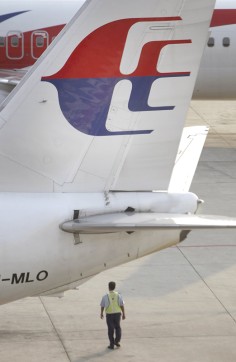Missing Malaysia Airlines jet could have landed on any large flat area, say experts
The number of suitable landing sites that could have been used by a pilot to touch down the missing Malaysia Airlines flight could far exceed estimates of 600 quoted in foreign media, Chinese engineering and aviation experts said last night.

But within that vast area, there could be tens of thousands more locations suitable for landing a jet, if pilot expertise and wide open spaces were taken into account, experts said.
Speculation that the plane is still intact and landed safely has been swirling in the absence of any evidence that it crashed, despite a 10-day hunt.
The WNYC radio station compiled the list of airstrips which was quickly picked up online.
Professor Gao Peiwei, who studies rapid construction and repairing technology for runways at Nanjing University of Aeronautics and Astronautics, said a Boeing 777 could be put down in various environments - even on highways and dirt strips - if the pilots had "knowledge and training for the specific location".

The surface of the runway, be it cement or dirt, must be hardened to take the weight of the jet's wheels and be long enough to allow for adequate braking.
"But of course, you can also land on a relatively soft surface and brace yourself for big bumps, if you don't care whether the landing gear or the plane can fly again," Gao said.
Any relatively large and flat area without high hills or tall buildings immediately in front of it could be used as a landing area, potentially adding tens of thousands more locations to the list.
"Large airports are equipped with sophisticated communications systems and supportive facilities such as lighting to make sure that every take-off and landing would be successful. If the purpose was to land the plane once and for all, most facilities are not necessary," Gao said.
One possibility to explain the disappearance of flight MH370 is that it landed at a private airstrip or on a military base and for political or other reasons, its arrival has not been made public.
"This is a wild guess, but with the information released by Malaysian authorities, anything is possible," Gao added.
Yang Xiaoguang, an aeronautics scientist at the Beijing University of Aeronautics and Astronautics, agreed with Gao that it was feasible the plane had landed on a small or temporary airstrip.
But he said it would take at least six months of work on the ground to prepare a suitable strip that could safely take such a huge aircraft. "You would need quite a few workers and machines to even the ground, if the site was chosen at a remote area," he said.
"To carry out such a task without it being detected is hard to believe, but that's the best we can hope for the passengers on board and their families."
Yang said contradictions between the Malaysians' early statements on the plane's disappearance and their more recent comments had made the Chinese aviation community suspicious that not all relevant information had been made public.
"We have a strong feeling that some information has been held back," he said.

